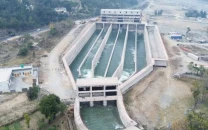Accumulated silt: Rawal Lake storage capacity shrinks by 37 per cent
The reservoir completed its life expectancy in 2012 but the authorities have failed to build an alternative dam

Anglers have returned to the lake after the ICT fisheries department recently lifted ban on fishing in the water reservoir. PHOTO: ONLINE
Sedimentation has reduced the storage capacity of Rawal Dam by 37 per cent and continuous inflow of silt is further reducing its capacity.
Experts said that the dam, the only reservoir catering to the needs of over 3 million residents of Rawalpindi, had completed its life expectancy.
The authorities have to discharge extra water when it rains to maintain the storage level.
Although the lake completed its life expectancy three years ago, the authorities have failed to build an alternative reservoir to cater to the needs of Rawalpindi residents who need 25 million gallons of water per day.
Read: Rs18 billion earmarked for dams in Pindi division
“Estimated life expectancy of a small dam stretches for 50 years. Rawal Lake’s life expectancy ended in 2012 and its storage capacity is decreasing by 0.21 per cubic meter a year,” Small Dams Organisation Sub-Divisional Officer Rana Bilal said.
He said that the organisation had built three ‘check dams’ upstream Korang River to stop further erosion and accumulation of silt in the lake.
“The check dams help store fast flowing silt and sediments,” said Bilal adding that proposals have also been floated to establish three more check dams upstream Korang River and other tributaries to contain the silt from flowing into the lake.
“We cannot take the risk and when the water level touches 1,752 feet level, we open the spillways to discharge the extra water,” Punjab Irrigation Department Executive Engineer Chaudhry Mushtaq told The Express Tribune.
“The silt inflow has increased significantly owing to excavation and growing construction activities in the catchment area including the Korang River during the last few years,” he said.
“A very short spell of rain forces the dam management to drain out the extra water through spillways,” said Siddiqa Malik, a resident of Bani Gala, which is in close vicinity to the lake.
She said that the authorities had never carried out de-silting operations to improve the dam’s storage capacity. She said that some individuals used to dredge the silt from the dam as it had great fertility value for agriculture purpose but the Capital Development Authority (CDA) prevented them to do so, causing accumulation of silt and sediments.
Read: Local needs: ERRA to construct small dam in Rawalakot
Malik alleged that the SDO wanted to raise the dam instead of dredging it because it involved kickbacks and commissions.
“In dams, dredging is not possible as it costs too much and two new reservoirs can be built if the same amount (invested on dredging) is invested in them,” Mushtaq claimed adding that before dredging, a reservoir or a dam has to be dried up completely.
Proposals have long been pending for the construction of Darocha and Chirah dams to supply water to the residents of the twin cities, but they have fallen victim to red-tape.
“The situation becomes serious during the dry spell when the water level drops to dead level in the reservoir due to silt,” he said.
The 8.8 square-kilometer lake is mainly fed by the Korang River and some other small streams flowing down the hills of Murree and Ghora Gali.
Published in The Express Tribune, July 13th, 2015.



















COMMENTS
Comments are moderated and generally will be posted if they are on-topic and not abusive.
For more information, please see our Comments FAQ